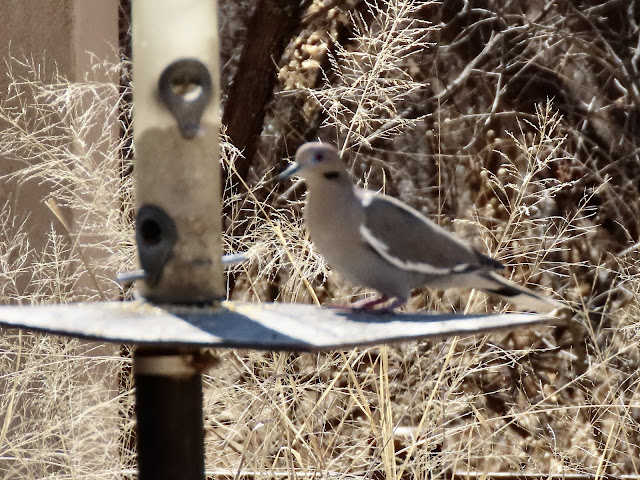Saturday-Sunday, March 12 & 13, 2022
DAY ONE: I-19 CORRIDOR
Although I had managed to visit I-19 birding spots during the Covid pandemic, two years have passed since I visited Sierra Vista. Many bird-friendly habitat changes have been installed in both areas.
Glenda Jones wanted to visit this area before returning home to Canada in just a few weeks. While I may not have headed out quite this early in the season, it turned out to be a wonderful trip. Visiting six (6) sites on Saturday along I-19 South and another six (6) on Sunday in Sierra Vista gave us both a satisfying birding "fix."
Winds were calm; sky was clear; temperatures varied with elevation and time of day for which we had come prepared.
From Montosa Canyon, Amado Water Treatment Plant, and dropping into the Hawk Watch at Ron Morris Park in Tubac, we were jazzed with the variety of birds observed. Best ones: NORTHERN BEARDLESS TYRANNULET and singing CANYON WREN at Montosa Canyon; six (6) LESSER SCAUP at Amado pond; leaving us with PLUMBEOUS VIREO as our best at the Hawk Watch. We did not stay long there. Hawk watching needs hours of time to enjoy the migrating birds who fly over. 
Canoa Ranch Conservation Park farther North along I-19 provided us with some spectacular waterfowl and a headache of sparrow species.
A REDHEAD is always a treat! While two COMMON MERGANSER swam the pond, it was the juvenile HOODED MERGANSER that caught my attention (thanks to Glenda). Note the spikey "doo' and dark eye in Photo #2 below. The SPOTTED SANDPIPER appeared ready to pop out into its breeding season spots, but lacks them in winter plumage, Photo #3 below.
A female AMERICAN KESTREL perched high looking over its choices.

And, then, there were sparrows, sparrows, and more sparrows! RUFOUS-WINGED, BREWER'S, LARK, WHITE-CROWNED, and VESPER.
Mid-afternoon by the time we arrived at Madera Canyon, we birded Proctor Road Loop with just seven species. Made special with one HUTTON'S VIREO and two COMMON GROUND-DOVE calling back and forth, we were delighted for having included the walk. Hopefully, Glenda can upload the recording she took of the rising inflection of the dove's coo-oo coo-oo sounds.
At Santa Rita Lodge, the highest count of one species, LESSER GOLDFINCH (50), followed by WILD TURKEY (16) was entertaining. Sometimes 12 or more goldfinch were on one feeder but I prefer photos of them on the trees when possible, below.
Just two species of hummingbird were present: RIVIOLI'S and BROAD-BILLED.
For me, the best bird that appeared at the feeding station was the male HEPATIC TANAGER.
DAY TWO: RAMSEY CANYON, BATTISTE'S BIRD GARDEN, ASH CANYON BIRD SANCTUARY, SAN PEDRO RNCA HOUSE AREA, and ST. DAVID HOLY TRINITY MONASTERY. (not. including birds submitted for East Box Canyon Road over to Route 82)

Spending two hours at Ramsey Canyon provided good exercise. Coues White-tailed Deer were grazing not far from the upward loop trail.
Several old cabins/buildings still stand in the forest.


Spending about 45 minutes at the San Pedro House grounds, there were many birds at the feeders. WHITE-WINGED DOVE are already there for the summer (not yet in AJ), and PYRRHULOXIA gave us some decent views.
With Glenda driving, I guided us home by way of US 90 to US 80 through Tombstone to St. David. There, we birded the Nature Trail and Pond. Waterfowl was abundant compared to previous visits.
Several pairs of AMERICAN WIGEON; MALLARD; MEXICAN DUCK; a pair of REDHEAD; and a single RING-NECKED DUCK (in view) have made themselves at home there.
For me, the attraction was the pair of VERMILLION FLYCATCHER.
Birding at that leisurely but constant pace is quite invigorating. Simply spending time in the natural world for two days was soul-satisfying.
Altogether, we visited twelve (12) birding sites and tallied 105 different species of bird. I'm chalking it up to the best birding adventure I've had since pre-Covid.
Till I get out and about again AND have time to blog, maybe I'll see you in the field.
* * *


























No comments:
Post a Comment